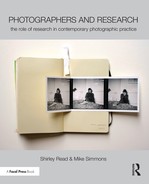Case Study
Martin Hartley
Martin Hartley is an expedition and adventure photographer who has worked extensively in polar regions. He works on and documents scientific expeditions as well as some of the world’s most inaccessible places.
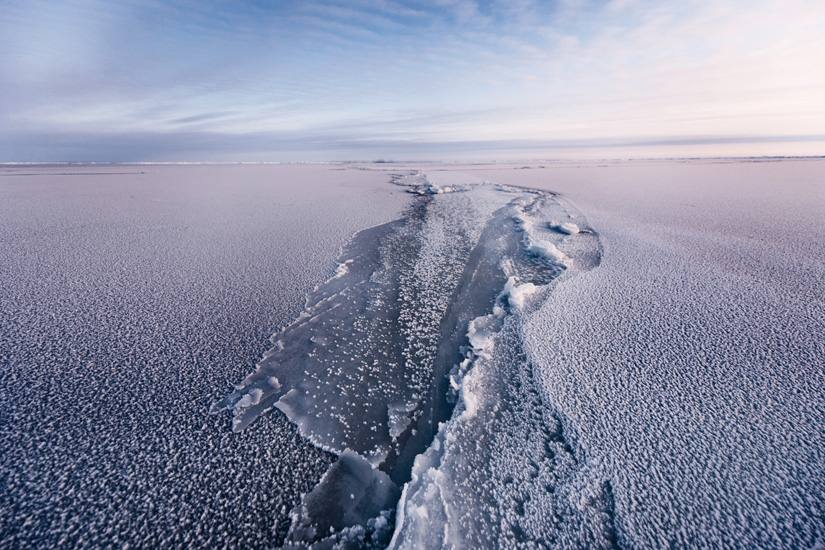
From the series Frozen Ocean: the beauty of Arctic Ocean surface travel is that no two hours of travel are ever the same, the landscape and the surface change with almost every step. Being surrounded by five million square miles of sea ice and nothing else; no resident population, no walls, no buildings, no fences and often no possibility of rescue plays a huge game with one’s psyche; one has to be in positive survival mode.
© Martin Hartley
ALTHOUGH THE WORK I DO is most often about documenting expeditions, simply being in the right place at the right time is not enough when shooting in inhospitable environments and poor weather conditions. You have to become efficient at two main kinds of research—into locations and into equipment.
The only ways to do this are through acquiring experience and by talking to other expeditioners because the information you need is not to be found in books, magazines or on the Internet. The advent of the Internet has made looking for information the easiest job in the world, you just have to commit time to doing it, but you won’t find very detailed and reliable information about things such as how to survive brutal weather on an extended Arctic Ocean expedition.
For me, the way to find people who have useful information about a remote place is through networking at the Royal Geographical Society. Photography in inaccessible places is unpredictable, generally speaking, because the environment dictates the work that you are able to do and you can’t research everything before you go because the variables are too wide for that to be really useful. You can’t pick up local knowledge till you are there so the key is researching a reliable on-the-ground fixer who literally knows the terrain, knows about things like translators and rescue services, and can also provide shortcuts to meeting people if you are intending to do interviews and/or portraits. You can only start thinking about the work itself when you have sorted this out.
However, the most important research I do is about equipment. The equipment has to survive the shoot; it also has to be appropriate to the environment and the circumstances, which will determine how much you can carry. When you depart base camp you have to carry everything you need for the entire expedition and, as well as the food and fuel everyone has, I have all my photographic equipment and all my back-ups, including spare camera, lenses, flashcards, batteries and charging devices. I don’t want anyone else carrying it, in case they lose or drop it, so I am carrying an extra 20 kilos of kit and have to make some compromises—the first things I don’t take are a tripod and long lenses.
Photographing on expeditions is, more than anything else, about having the most reliable equipment and if any part of that equipment fails you need to have the right kind of back-ups to keep the system working. My first photography assignment in the High Arctic1 was for The Times and I thought, not having done any research, that if I took a lot of equipment then, if one camera system failed, another would keep working. Because I had no experience of it I didn’t anticipate a temperature of minus 48 degrees Celsius plus a 40-knot wind, which brought the temperature down to minus 71 degrees, and hadn’t prepared for that kind of cold. My clothing was, I thought, OK but, in fact, it was inappropriate and I had to borrow thermals, gloves, hat and boots. And all the cameras I had, six in total, had exactly the same problem and they all became extremely stiff and unmanageable because of the cold so lenses wouldn’t focus, film wouldn’t wind on and the tiny batteries wouldn’t stay at the right temperature for long enough.
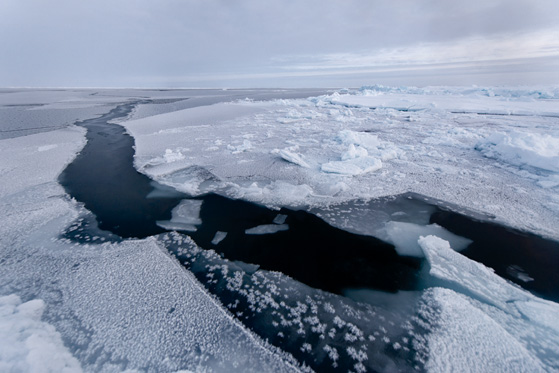
From the series Frozen Ocean: below minus four Celsius newly exposed seawater freezes on contact with the atmosphere. Unlike fresh water saltwater ice remains flexible, almost like a rubber sheet. As the newly open lead closes, squeezing the newly formed ice, the surface becomes more uneven and cracks again.
© Martin Hartley
But that was back in 2002 and now all modern cameras have lithium ion batteries and perform well in temperatures down to minus 30 degrees C. I also carry a brass body, fully manual Leica MP, which doesn’t seem to be affected by the cold. But film, and especially the sprockets, become brittle in the cold so I have to remember not to shoot the last frame because, if I do, the film will be so tight that it will snap when I try to rewind it. It’s too difficult to change the film in these temperatures and on the move so I only use one film a day. But, because the Leica is all metal, I can hang it over the petrol stove in the tent in the evening and just give it a push from time to time and then change the film. Before I learned how to keep cameras warm I had an electrical engineer take a camera apart and add an internal heater and make the battery external but then it was heavy and clumsy and didn’t keep the lens warm.
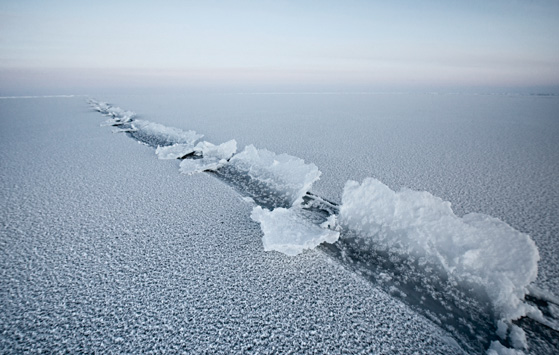
From the series Frozen Ocean: these two perfectly intertwining blades of ice lock together like gigantic fingers clasping, hence the name ‘finger ice’. This ice forms when a crack has opened up and is then closed again before the ice has become solid. The ice then splits and grows like this while it is still malleable.
© Martin Hartley
On that first Arctic trip I got lost and scared to such a point that I didn’t want to take pictures and I didn’t want to go back to the Arctic again afterwards—and that’s what happens if you don’t prepare mentally and physically. If you are not ready for worst-case scenarios that are not photographically related, i.e. if you are not comfortable in the environment you are in, whether it’s a mountain, desert or polar region, then you cannot access your photographic brain.
This sort of practical, physical research is always very important for me because if you end up in a country with the wrong skills to move around effectively and efficiently—mountaineering, skiing, dog sledding, yachting—then you are dead in the water.
I once had a phone call from a new client, Berghaus, who asked if I could ski because they wanted photographs of a group climbing the highest active volcano in Russia and then skiing down. Their phone call came only five weeks prior to departure because the photographer they had originally commissioned had broken a rib in training. At that time I couldn’t ski at all but said ‘yes, I can’ because my being a more than adequate skier was not in itself important. I took myself off to Chamonix for a week and my brief to the ski instructor was to teach me to get down anything—not with style but safely—in five days of instruction. It worked and I applied everything he taught me and that was far more important than getting stressed about the photography part of the brief. Because if you can’t look after yourself, you can’t think about taking pictures.
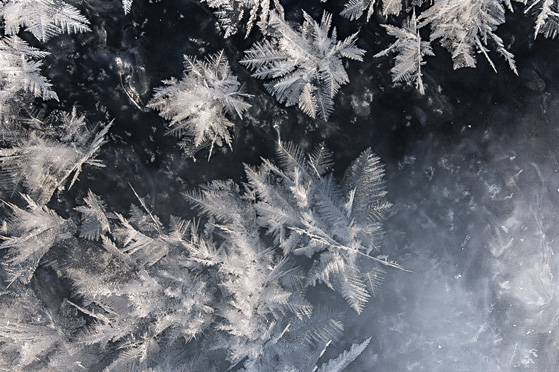
From the series Frozen Ocean: as soon as new ice begins to form the salt comes out of solution and beautiful ‘flower beds’ of tiny salt flowers begin to form. In order for these crystals to grow the temperature needs to be well below freezing and the wind to be zero. Once the wind picks up or the temperature rises these ‘flowers’ become rounded and lumpy and look like mini brussel sprouts.
© Martin Hartley
Part of my physical preparation is training and I go for long runs or bike rides in the cold not wearing quite enough clothing. I don’t go running with anyone or take headphones because it’s important to get used to the boredom of your own thoughts. You can also take a lactate curve test that tells you which heart rate to train at to metabolise fat and knowing that means that when I am pulling a sledge my body is being as efficient as it can be in absorbing food and turning it into energy.
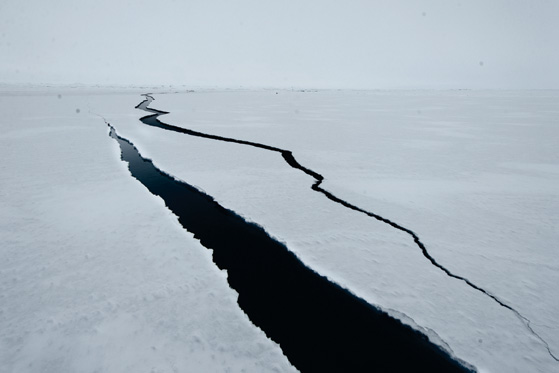
From the series Frozen Ocean: the surface of the Arctic Ocean is a dynamic surface and in constant motion, either being blown by the wind or the undersea currents pushing the ice around. Cracks open and close frequently and always unpredictably. It’s not unusual for a crack to appear suddenly under your tent and from that point rapid evacuation becomes a serious priority.
© Martin Hartley
Quite often, once a team has been selected, we will go away together and purposely make our lives as uncomfortable as possible to test our ability to work together. This might mean walking for miles, swimming across a lake fully clothed or abseiling in the dark and being wet and cold and miserable all the time just to push the experience of working as a team. Everyone will know basic first aid, from stitching up a wound to how to treat a burn or frostbite, and we always have a specialist doctor on call 24 hours a day. Nowadays you can also go on a course on expedition medicine at the Wilderness Medicine Society.
As part of my mental preparation when I am in bed at night I try to imagine I’m sleeping in a tent in the middle of nowhere because the transition from a heated house to an unheated tent with no water, no bed and not much space, which will all have happened within about 12 hours, can be quite a headfuck. The knowledge that you can’t just walk into a heated building when you are cold freaks some people out. It is quite hard to imagine that you are in the middle of five million square miles of ice and nothing else.

From the series Frozen Ocean: the age of the ice can be determined by its depth; the average thickness of ice on the Arctic Ocean is 1.77m – less than half the average thickness when Peary was attempting the North Pole in the 1900s.
© Martin Hartley
Another thing that is unique to my kind of work is that before each expedition I have to research the latest, fastest and cheapest way to send pictures back. In 1999 in Borneo we made the first live video transmission onto a server on a live expedition website, set up by Dan Haylock and a company called Live TX. Since then, the weight of the equipment has gone down from about four kilos to less than half a kilo. During 2014 I had to re-equip and I can now sit in a tent on the frozen Arctic Ocean and send photographs I’ve taken that day from my smartphone using a satellite transmitter the size of a cigarette packet.
Once you have become more experienced and capable in a particular environment you become familiar with evil things like pain and learn how to manage yourself when things are difficult. It’s a bit like learning to drive—when you first learn you can’t think about anything else because you are far too concerned with the practical elements of keeping control of the car. Once you have been driving for a few years your subconscious takes over and frees you up to think creatively. It’s exactly the same in extreme environments —once you can look after yourself naturally and subconsciously your creative thinking can come out. I am now much more experimental in my picture making and will try to think of the most difficult shot possible and chase after that rather than do the easy things you do at first. When you are cold and tired and uncomfortable your mind will only stretch to do the bare minimum photographically. The first time I was in the Arctic and got lost I stopped taking photographs even though it was absolutely beautiful.
Before I did anything on polar expeditions I had to know about Herbert Ponting2 and Frank Hurley3 who are the quintessential polar photographers. Ponting had the ability to turn quite a harsh environment into something beautiful and poetic. Hurley never ceases to amaze me because he always got his camera out in the most difficult of circumstances, for instance when they were marooned for 18 months he documented their survival to the very end. It’s difficult not to compare what they’ve done with what I’ve done. I think about them all the time on expedition and whenever I’m feeling tired or lazy I think about them and get my finger out. On the last two expeditions I did I researched both Ponting’s and Hurley’s photography before I went and tried to emulate it using an old camera and film to try and see how close a modern expedition would look to an early one—clothing has changed but the environment remains the same.
But their approach, which was that they were there to collect information, has also influenced my attitude to what I do. Because scientists don’t have the skills to travel over the surface of the frozen Arctic Ocean I do data gathering on their behalf when I can. I think it’s irresponsible to travel on an expedition today and not gather some sort of data—because unless that’s what you’re doing, it’s a holiday and not an expedition.
Another key thing in all these long journeys is to have some degree of pre-visualisation of the kind of shots that you want to return with. I learned this from one of my photographic heroes, Galen Rowell,4 who suggested building the idea of a picture in your head and then going to look for it. It’s a technique you have to practise.
For example, I was commissioned to photograph Pen Hadow on his North Pole solo expedition in March 2002 so I had to come back with a picture that showed Pen on the day he arrived at the North Pole. Obviously, I wasn’t going to be there with him because it was a solo journey but I had to take an image that could reflect his being at the Pole so I looked through other adventure photographers’ work to try and see how I could represent this—after all, the North Pole is just an imaginary point on the ‘top’ of the globe. Galen Rowell was a big inspiration and as a result I came up with the idea of photographing Pen as if he was actually at the top of the world. I decided to use a semi fisheye lens. I needed to find a small frozen lake and a stepladder. The only thing I couldn’t organise was a bad weather day to hide the background—as it happened I found the right place and the stepladders in Resolute Bay in north-east Canada and had only to wait for the weather to be right.5
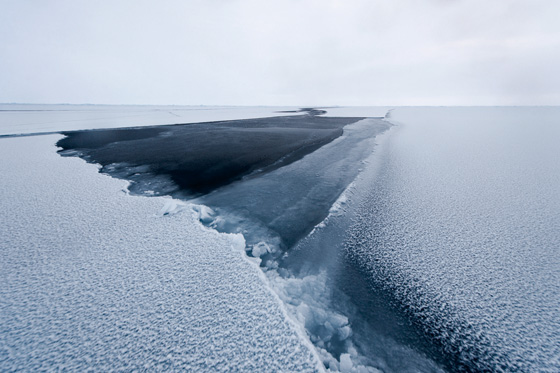
From the series Frozen Ocean: the process involved in creating a litre of water from the ice is a protracted and labour intensive job. I have often thought, while watching a small block of ice as it slowly melts over the stove, that the energy required to change ice back into water seems entirely disproportionate. If you consider that the entire North Pole ice cap is thinning rapidly this gives some small insight into the amount of energy required to achieve this. Global warming is making it possible to melt five million square miles of ice when it takes me five hours to make just six litres of water using a very hot flame.
© Martin Hartley
If I’m travelling with a writer on an assignment the writer will generally set out with a specific agenda, which we will usually have discussed. So, before we leave I have to think of what kinds of images will tell the story but the writer will often come away with an entirely different story to the one s/he anticipated writing. You have to be experienced enough to be adaptable.
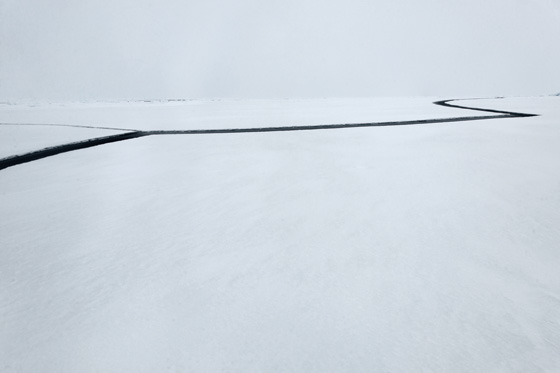
From the series Frozen Ocean: under a new full moon the tidal effect gets a grip on the Arctic Ocean in the same way it does everywhere else on earth as the gravitational effect of the moon temporarily changes the shape of the earth’s surface enough to bend the ice. This causes widespread breakup three days before and after the new moon and it is a particularly awkward time to be on the ice.
© Martin Hartley
For example, in 2001 I went to photograph a small, remote community whose culture was under threat from a road being built to a town 180 miles away—that was the story we set out to tell and we wanted to document the village and the culture before the road reached it. I travelled with a writer and an anthropologist who knew the culture and the people. What shaped the story was the anthropologist’s research about the farming of the grain, tsampa, in the village so the story ended up being about food and the culture around the food more than about the road that was due to be built. An influencing factor in that was that my photographs around the food culture were rich in information and laden with storytelling possibilities.
I do have to have a very rounded view of the kind of pictures I can anticipate coming back with so I’m thinking about what kinds of image would tell or back up the story and I do that before we leave. A relatively new thing is if I am researching a job now I go online and research other photographers—this is a lot easier than it used to be because you don’t have to go and find appropriate bookshops—and look at how they have dealt with the same subject and look at adopting and evolving some of their techniques and ideas. I try and see what’s gone before and measure my work against theirs, usually from a technical point of view.
I don’t keep records of each journey or a diary and I regret it. Captain Scott and Edward Wilson6 both kept a diary and Wilson painted daily in his. There is no excuse not to except that Wilson was based in one place and so had time and I’m on the move and my spare time is taken up providing digital assets, usually a written document and an image, to the world outside my tent.
It’s unusual for me to be able to look at one of my photographs and be happy with it. The only things I see are what can be improved. I’d go so far as to say that out of several million photographs I’ve only made a few I’m pleased with.
From a creative point of view I know if I’m happy with a project. I can measure this by the times when I’ve come back from an expedition with a different way of showing something I’ve photographed before. From a commercial point of view it’s very measurable in terms of social media. If your number of followers on Twitter or image shares on Facebook, Pinterest, Behance and expedition website click-throughs isn’t high the sponsors want to know where the problem is—immediately and during the expedition.
I evaluate my work when I get back by comparing it with my previous work and while on an expedition assess it on an ongoing daily basis, which you can do with digital and couldn’t with film. I’m looking at how the story is evolving in terms of images; commercial pressure means I have to have a live daily presence by image sharing so I can tell by the response how successful they are. The interesting thing about social media, specifically Twitter and other image-sharing websites, is that you can actually measure the response from the audience. When I was away last year I took a picture of tiny salt crystals and that picture has been seen in ‘impressions and engagement’ 162,000 times.7
In addition, you get live feedback coming to the expedition when you make the daily phone call back to base to let them know how you are physically and what your intentions are for the next day. So, for example, on the last expedition I was taking photographs of epic landscapes and the occasional portrait and people were asking for images of life inside the tent and photographs of food and cooking. Even, for example, that on a polar expedition we have to collect and melt snow every day to drink and to rehydrate food with, which is a mundane, boring process to watch but people back home find it absolutely fascinating, so I photographed it, which I probably wouldn’t have done before I got that audience feedback.
The pressure now on expeditions—even though every day is exactly the same—is that you have to show something new every day to keep hold of your audience. I try and make that part of it up as I go along and to remember what is normal and uninteresting to me is not necessarily normal or uninteresting to someone who has not been in that particular environment. It took contact with the audience to help me see that and start photographing our daily routines as modern day explorers.
So, I do now think about my audience a lot because the process has become quite interactive, whereas before there was only a post-expedition audience. Before, it was more or less the people who were in a dimly lit room with a slide projector—just like Ponting and Hurley—whereas now it’s a global and live audience who are looking at work on their mobile phones and laptops wherever they happen to be. On the last expedition I didn’t post a picture on one particular day because I was simply exhausted and straight away the sponsor was demanding the pictures from that day.
My approach doesn’t change much from project to project now; I know where to find the information I need. But there is never enough time—usually the funding comes in so late that I don’t have time for all the research I would like to do and only experience helps when you have to make it up as you go along.
One good thing about research is that it gives you a plan and the good thing about having a plan is that you can always change it.
Interview by Shirley Read
Note about the photographs: Frozen Ocean is personal work documenting changing ice formations in the Arctic and not part of Martin Hartley’s commissioned editorial work.
Notes
1 The Arctic consists of the Low Arctic and the High Arctic, which are defined by different types of environment rather than their geographic location. The High Arctic is an area of polar barrens that are beyond the tree line, have sparse vegetation but are not areas of permanent ice and snow. The Low Arctic is characterised by tundra and more vegetation and is more habitable.
2 Herbert Ponting (1870–1935) was a professional photographer and cinematographer best known for his photographs from Scott’s expedition to Antarctica in 1911–12. His archive is held by the Scott Polar Research Institute in Cambridge.
3 Frank Hurley (1885–1962) was an Australian photographer and cinematographer known both for his photographs of expeditions to Antarctica and for his images of two World Wars. Unlike documentary photographer Ponting, he constructed and posed his photographs. His work is held in a number of collections in Australia and by the Scott Polar Research Institute in Cambridge.
4 Galen Rowell (1940–2002) was an American climber, writer and wilderness photographer. He was published in magazines including the National Geographic and Life and won the Ansel Adams award for Conservation Photography.
5 See: www.martinhartley.com for this photograph or Huw Lewis-Jones (2008). Face to Face: Polar Portraits. Cambridge, England: Scott Polar Research Institute. Photography by Martin Hartley (frontispiece).
6 Edward Wilson (1872–1912) was a doctor, naturalist, painter and ornithologist who travelled to Antarctica with Scott on the Discovery and the Terra Nova expeditions.
7 ‘Impressions and engagement’ are social media definitions used to assess and denote popularity.
